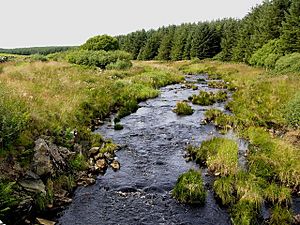Tarf Water, Wigtownshire facts for kids
The Tarf Water is a river located in the southwest part of Scotland. It flows through an area that used to be called Wigtownshire. This river is not very long, but it plays a part in the local landscape.
Contents
Tarf Water: A Scottish River
The Tarf Water is a smaller river in Dumfries and Galloway, a region known for its beautiful scenery. It's a great example of the many rivers and streams that crisscross Scotland.
Where Does Tarf Water Start and End?
The Tarf Water begins its journey right on the border of Ayrshire, another area in Scotland. From there, it flows mostly towards the southeast. After its journey, the Tarf Water joins a larger river called the River Bladnoch. This meeting point is close to the small village of Kirkcowan.
What's Around Tarf Water?
The Tarf Water doesn't have any big rivers flowing into it. Instead, many smaller streams, called "burns" in Scotland, feed into it. These burns collect water from the surrounding land.
The area around the river is special because it has many drumlins. Drumlins are small, oval-shaped hills that were formed by glaciers long ago. Imagine a giant ice cream scoop moving across the land, leaving behind these smooth, rounded hills! Much of this area has also been afforested. This means that many trees have been planted there, turning open land into forests.
What Does the Name "Tarf" Mean?
The name "Tarf" for this river is very old. It comes from an ancient language called Proto-Indo-European. In that language, the word *tauro- meant "bull" or "aurochs" (a type of wild cattle that is now extinct).
It might seem strange for a river to be named after a bull! But in old Celtic stories and myths, bulls were often very important. So, the name "Tarf" might have a mythological meaning rather than just describing real bulls in the river. The name "Tarf" is similar to words in Gaelic, but it probably came from an even older language called Cumbric, which was once spoken in this part of Scotland.


